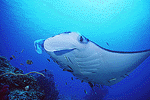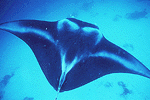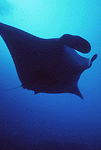PHOTO TIPS FOR PALAU DIVING
MANTA PHOTO TIPS
Text and Photos by Kevin Davidson
 In most cases mantas are most easily photographed at some sort of cleaning station, quite often in channels where current is running. A manta does not swim up to you and wait for you to take its picture. At cleaning the manta will pass over the coral head and hold position for a bit. This is where you'll need to use a little judgment on how close to get. Don't forget about a gentle presence on the reef and don't charge into things. If you seem to have scared him away, be patient and see if the great beast comes back around in a few minutes for another pass. If you are lucky enough to have one hold its place on the cleaning station you are able to get several shots and perhaps one or two of your shots will be successful.
In most cases mantas are most easily photographed at some sort of cleaning station, quite often in channels where current is running. A manta does not swim up to you and wait for you to take its picture. At cleaning the manta will pass over the coral head and hold position for a bit. This is where you'll need to use a little judgment on how close to get. Don't forget about a gentle presence on the reef and don't charge into things. If you seem to have scared him away, be patient and see if the great beast comes back around in a few minutes for another pass. If you are lucky enough to have one hold its place on the cleaning station you are able to get several shots and perhaps one or two of your shots will be successful.
Here are a few tips to keep in mind when photographing mantas:
 The underside of mantas are usually white so if you are going to shoot from beneath, then you might not need so much strobe power. While on route to your manta site, point your camera and meter straight out into the open water or just slightly upward to the water column and adjust the shutter speed to around 1/60 or 1/125 second. Set your strobe to 1/4 power or 1/2 power, if these settings are available. Since most cameras and strobes work at 1/60 or 1/90 shutter speed, you are letting in enough ambient (surrounding) light and the strobe can fire to fill in the foreground. With the power cut down you'll be less likely to overexpose the shot. In addition, the strobe will recycle faster, allowing you to take another shot sooner and end up with more shots.
The underside of mantas are usually white so if you are going to shoot from beneath, then you might not need so much strobe power. While on route to your manta site, point your camera and meter straight out into the open water or just slightly upward to the water column and adjust the shutter speed to around 1/60 or 1/125 second. Set your strobe to 1/4 power or 1/2 power, if these settings are available. Since most cameras and strobes work at 1/60 or 1/90 shutter speed, you are letting in enough ambient (surrounding) light and the strobe can fire to fill in the foreground. With the power cut down you'll be less likely to overexpose the shot. In addition, the strobe will recycle faster, allowing you to take another shot sooner and end up with more shots.
Now this will get you close, while allowing you to reach up and turn off your strobe to also do a few natural light shots if the water is clear. Now I know most of us are too excited to remember to mess with the strobe once things get going. This is why you should adjust your camera ahead of time. At least you'll have something in your favor, even if you forget the rest of the steps. Of course those who do remember, can still change f-stop around to fine tune shots even more. Every water column is different and the suns position will also effect the conditions, but with this tip may be helpful in some instances.
 For those with point and shoot cameras or with limited controls, remember to follow instructions on proper film use. Some suggest ASA 100, 200 or 400 . Stay within the parameters of your lens, which holds true for all cameras. Smaller strobes on these cameras don't reach as far so try to get within four feet or so for effective strobe coverage. Don't be afraid to try natural light. Diffusing the smaller strobes is not always a bad idea either. A white sock over the top or clear plastic lids are some of the things I have seen and used myself, all with some degree of success. You are cutting down the light but you will not overexpose the picture.
For those with point and shoot cameras or with limited controls, remember to follow instructions on proper film use. Some suggest ASA 100, 200 or 400 . Stay within the parameters of your lens, which holds true for all cameras. Smaller strobes on these cameras don't reach as far so try to get within four feet or so for effective strobe coverage. Don't be afraid to try natural light. Diffusing the smaller strobes is not always a bad idea either. A white sock over the top or clear plastic lids are some of the things I have seen and used myself, all with some degree of success. You are cutting down the light but you will not overexpose the picture.
In my page about sharks, I write of the necessity of having a "feel" for what your camera does. This sounds pretty broad, but when you make a point to remember what you did you will be able to fine tune your technique. What's more important is to be able to recognize when there is a great shot at hand, but also know when not to take the shot! All the fancy photo gear in the world will not help a rainy day bad visibility and all the other thing mother nature throws at us.
Underwater Digital Photography Online Courses
Web Site Design | Photography | Destination Info | About Us | News & Events | Site Map | Search | Home | Copyright
 In most cases mantas are most easily photographed at some sort of cleaning station, quite often in channels where current is running. A manta does not swim up to you and wait for you to take its picture. At cleaning the manta will pass over the coral head and hold position for a bit. This is where you'll need to use a little judgment on how close to get. Don't forget about a gentle presence on the reef and don't charge into things. If you seem to have scared him away, be patient and see if the great beast comes back around in a few minutes for another pass. If you are lucky enough to have one hold its place on the cleaning station you are able to get several shots and perhaps one or two of your shots will be successful.
In most cases mantas are most easily photographed at some sort of cleaning station, quite often in channels where current is running. A manta does not swim up to you and wait for you to take its picture. At cleaning the manta will pass over the coral head and hold position for a bit. This is where you'll need to use a little judgment on how close to get. Don't forget about a gentle presence on the reef and don't charge into things. If you seem to have scared him away, be patient and see if the great beast comes back around in a few minutes for another pass. If you are lucky enough to have one hold its place on the cleaning station you are able to get several shots and perhaps one or two of your shots will be successful.
